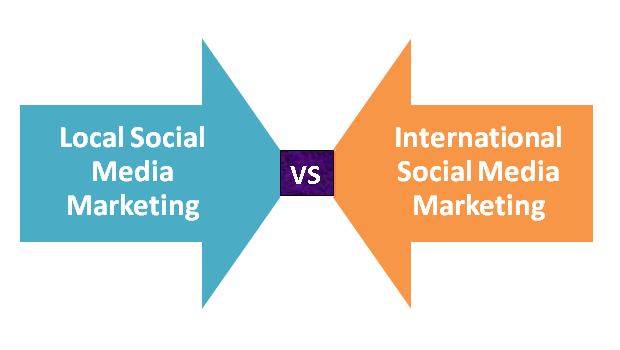
One of the biggest shifts we’ve since seen in the last year for social media marketing has been the increasing use of international campaigns. This is not very surprising when you consider how globalized our economy has become and the fact that US companies are voraciously spreading their brands to new territories for easy profits. Mirroring this trend is the online move for social media to spread people’s awareness in new territories as well as handle support and complaints efficiently overseas.
The statistics are clear: Around 80% of Facebook’s users are outside the US and Canada and roughly 70% of Twitter’s user base too. This just goes to show how many people are currently being left out in the cold.
The real challenge here is to tackle the situation exactly the same way you would back home; with people deep inside your organization who speak the language and understand the culture. This is essential to build social media trust and will prevent anyone on the receiving end of your messages feeling like they were just an afterthought in a cold, corporate strategy drummed up in a board meeting.
Skip It?
Perhaps most importantly, you need to ask yourself whether or not your campaigns should even be ported overseas at all. Not every country or territory is going to be receptive to your brand, product, message or service. So be selective and make sure you can dominate the space before you enter it. This can be a daunting process since campaigns launched in the States not only have to be localized for each market, but sometimes they have to be scrapped and thrown out altogether. If you are doing a Super Bowl social media promotion for example, how would you translate the term ‘Super Bowl’ from English to Swahili so people will know you’re talking about a sporting event and not some amazing dish you’re dying to cook for them?
Then there’s the challenge of meeting them on their own home turf. While Facebook and Twitter seem to be popular in most countries, others are dominated by completely different platforms like Orkut, Tuenti or VKontakte. These will have to be leveraged, and, in some cases, even learned to meet your target demographics where they are.
Of course many products have strange crossover appeal too. For example, video games are mainly popular with younger boys in the States, but in many Asian countries certain games are just as popular with girls. Can you be sure your product will be accurately represented in each territory?
The Topic of Translation
As most people are fully aware, when they log into their Facebook accounts, automatic translation software is far from great. It will be a good few years from now before we’ll see decent translations that we can understand from our robot brethren. All of this means one thing and one thing only – native translators doing the work. Of course this approach can be time consuming and expensive, so it will have to be factored into your budget. But the thing is, only native speakers will know what’s funny, culturally relevant, interesting or just flat out boring for their market. A local team can do a great job of advising you on campaigns and saving you tons of time and hassle down the road. Don’t be afraid to take their advice, change campaigns or switch up your promotions if they’re doomed to fail before they even get off the ground.
Here are some examples how Starbucks and Uniqlo are doing all this and dominating with their campaigns…
Starbucks
Starbucks is one of the undisputed kings of social media. They have such an authoritative brand presence that they don’t necessarily need the social media to enhance their brand but they still use it as an effective tool to communicate with their customers. Interestingly enough, most of Starbucks’ tweets start with an apology. While other companies like to sweep problems under the rug to look good, Starbucks goes out of their way to encourage customers to tweet their problems so they can solve them.
A very mature approach.
They even have their own mini social network if you will, called My Starbucks Idea. This is a stroke of pure genius. It allows anyone to post ideas they would like to see incorporated into the company and then everyone can vote on them. Starbucks then follows up on the ideas with their blog to keeping people informed about what they’re doing with it. This not only gives the chain priceless ideas and feedback, but it also fosters a culture of customers feeling appreciated.
A huge win/win!
To keep things local in China, Starbucks decided to embrace the WeChat network which allows them to access millions of young careerists (their perfect market). So they created a custom QR code which allows anyone to add them as a contact. Once connected, Starbucks will send you a short music video advertising one of their drinks and begin building the relationship.
Starbucks is the benchmark for how everyone should be using social media.
Uniqlo
While Starbucks is the king in the food world, Uniqlo is making big strides in the clothing industry. For each country they have a presence in, they have dedicated unique social media accounts for each. They want to ensure that each territory’s profile is a tailored, accurate reflection of the needs and issues that come up. In the US for example, they have 528,000 Google +1s, while in the UK their numbers pale in comparison with only 270. In China they have a strong presence on Renren because it is so incredibly popular. They keep their content very local and highly relevant and their levels of engagement vary drastically from country to country too, which is to be expected.
The Challenges Ahead
Like any new space, technology or undertaking, there are bound to be some major hurdles and perhaps even disastrous mistakes ahead – just like we’ve seen with so many big brands in the last year.
So the questions that need to be addressed are: how do you plan to meet the varied needs of people speaking different languages and spread across multiple time zones? How do you align your social media marketing strategies as per the needs and priorities of different markets worldwide?
This is something many brand managers and social media marketers are thinking about right now. So any brave entrepreneur out there that wants to tackle the space with a smart solution, now is your time to dive right in. I’ll applaud you and most probably be one of your first customers.
Key Points to Keep in Mind when Handling Social Media on a Global Scale:
1. One account vs. Multiple Accounts – Should you have one social media account to cater to your global audience or should you create different accounts based on the country you’re present in? Should these accounts be handled centrally or should you appoint native account managers for each region? Native account managers have more of an inkling of what would and wouldn’t work in their geography. Organizations thus need to create a flexible framework that’s practical and mentions clearly who needs to do what and when.
2. Being Careful With Translations – There have been quite a few marketing blunders committed by companies when promoting their products. Pepsi, KFC, Coca Cola in China, Parker Pens in Mexico… the list is endless. You do not want to depend on literal translations or translations that have not been proofread by a native of that language.
When Pepsi started marketing its products in China a few years back, they translated their slogan, “Pepsi Brings You Back to Life” pretty literally. The slogan in Chinese really meant, “Pepsi Brings Your Ancestors Back from the Grave.”
KFC experienced some real problems when its phrase “Finger Lickin Good” came out in Chinese as “Eat your fingers off”
Parker Pens tag line – “It won’t leak in your pocket and embarrass you” when translated in Mexico came out to be – “It won’t leak in your pocket and make you pregnant”.
Important Tip for Marketers – Be aware of the nuances and differences in each culture. A small mistake can turn out to be a huge blunder and embarrassment for the company worldwide. Avoid relying too much on Google Translate to create local language content.
3. Fragment your Markets – Treat each market individually; don’t assume reactions and responses will be the same to a common campaign you may decide to run. A campaign that’s successful in UK may not succeed in Spain, Portugal, France or Belgium. Understand the traits and act accordingly.
For example – If your target is Singapore you need to take care of the fact that Singapore audiences are made up of people from India, China, Malaysia etc. Hence keep a check on different races, religions and beliefs. You don’t want to put up any content that’s offensive in nature to any of those communities.
4. Dealing with a Crisis – Make clear guidelines on what action to take in times of a crisis. Define issues that can be handled by the social media team or if it has to be escalated to the top management. Ensure you have a Plan B ready always.
5. Connect With Your Audience – Make your audience a part of your conversation. Ask them for suggestions, creative ideas, tips and tricks on how you can make your offerings better. While this would apply to even a local social media campaign you run, it’s even more important to do when operating things on a global scale because it’s very easy to get lost and carried away with your own assumptions of what your audience is looking at without really connecting with them and finding out directly.
6. You will make mistakes, learn and adapt – It’s difficult to handle the intricacies of international social media campaigns without making a blunder or two. Accept that it might just happen and be ready on to quickly recover/adapt.
While it’s still a big mystery and very little is known about international social media marketing, there’s an exciting future ahead for sure. But either way the same rules apply with complete transparency and honesty being the name of the game. When in doubt or if someone makes a mistake, just politely own up, say sorry and move on. It works just as well in any language.



